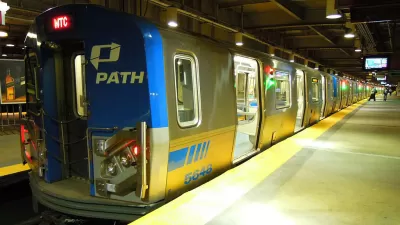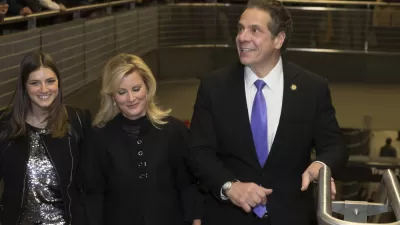As an alternative to raising the nation's second lowest gas tax (but lacking Alaska's oil wells), The Record found that Gov. Christie diverted toll revenue from the Port Authority and used them for state-owned facilities such as the Pulaskie Skyway.
Toll revenue that the Port Authority of New York and New Jersey collects from tolls on bridges on Hudson River crossings (which we recently described as the "agency's lifeblood") is supposed to be used for Port Authority facilities unless approved otherwise.
However, "according to dozens of emails, confidential memos and internal reports obtained by The Record," some of these revenues are "being used by the Christie administration to prop up New Jersey’s overburdened and underfunded transportation fund in a move questioned by Port Authority lawyers in late 2010 as being outside the legal scope of the agency’s authority," writes The Record's Polk Award-winning journalist, Shawn Boburg
Laws prohibit the agency from spending money on projects outside its transportation network unless they are specifically approved by lawmakers in both New Jersey and New York. But Christie announced the funding in early 2011 without seeking legislative approval or getting Port Authority lawyers to sign off on the move.
Boburg writes that $1.8 billion of Port Authority revenue was diverted "to New Jersey, even though several high-level Port Authority officials expressed concern that the projects it would fund — repairs to four North Jersey roads including the crumbling Pulaski Skyway — have tenuous connections to the Port’s cross-Hudson network."
This is not the first finding of Port Authority funds being used for New Jersey Roads. Two years ago, The New York Times tied Gov. Christie's cancellation of the Hudson River rail tunnels project in 2010 to shoring up the state's ailing transportation fund (and posted here). The cancellation has reappeared in relation to the investigation of the September road closures.
The Port Authority's toll incrases in 2011 are another controversial topic facing both Christie and N.Y. Gov Andrew Cuomo. Boburg's colleagues at The Record wrote on March 2 about "new allegations that (Christie's) top appointees at the Port Authority proposed a series of inflated toll hikes in 2011 designed to make the governors of both states look good when they opposed them."
In the video of the $1 billion, 80-year-old, 3.5 mile Pulaski Skyway rehabilitation that appears in the article, NJ DOT assistant commissioner Richard Hammer states, "We are spending $750 million annually in bridgework in the state," but doesn't indicate the source of the funding. New Jersey's 14.5-cent gas tax (excise tax of 10.5 cents plus 4 cents in other taxes) hasn't been increased since 1992.
CBS 2′s Scott Rapoport reports that "State Sen. Raymond Lesniak, D-Union, introduced legislation (March 17) that would raise the tax five cents a gallon a year for the next three years. However, judging by the video in the news report, that bill is not going over well with the state's motorists.
FULL STORY: Christie's toll-money shuffle: Port Authority funds paying for repairs to state roads

Study: Maui’s Plan to Convert Vacation Rentals to Long-Term Housing Could Cause Nearly $1 Billion Economic Loss
The plan would reduce visitor accommodation by 25,% resulting in 1,900 jobs lost.

North Texas Transit Leaders Tout Benefits of TOD for Growing Region
At a summit focused on transit-oriented development, policymakers discussed how North Texas’ expanded light rail system can serve as a tool for economic growth.

Why Should We Subsidize Public Transportation?
Many public transit agencies face financial stress due to rising costs, declining fare revenue, and declining subsidies. Transit advocates must provide a strong business case for increasing public transit funding.

How to Make US Trains Faster
Changes to boarding platforms and a switch to electric trains could improve U.S. passenger rail service without the added cost of high-speed rail.

Columbia’s Revitalized ‘Loop’ Is a Hub for Local Entrepreneurs
A focus on small businesses is helping a commercial corridor in Columbia, Missouri thrive.

Invasive Insect Threatens Minnesota’s Ash Forests
The Emerald Ash Borer is a rapidly spreading invasive pest threatening Minnesota’s ash trees, and homeowners are encouraged to plant diverse replacement species, avoid moving ash firewood, and monitor for signs of infestation.
Urban Design for Planners 1: Software Tools
This six-course series explores essential urban design concepts using open source software and equips planners with the tools they need to participate fully in the urban design process.
Planning for Universal Design
Learn the tools for implementing Universal Design in planning regulations.
City of Santa Clarita
Ascent Environmental
Institute for Housing and Urban Development Studies (IHS)
City of Grandview
Harvard GSD Executive Education
Toledo-Lucas County Plan Commissions
Salt Lake City
NYU Wagner Graduate School of Public Service




























